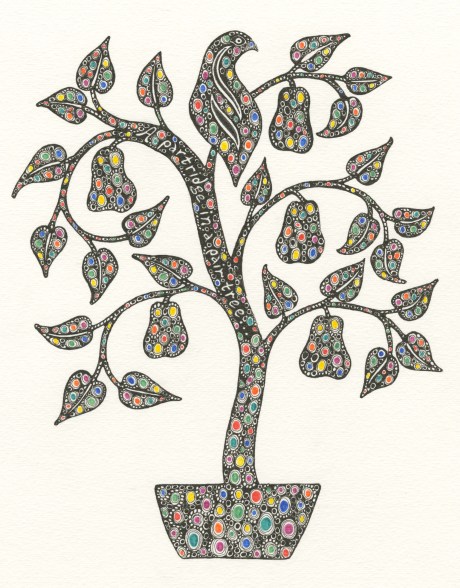“Twelve Days” Song
December 6, 2016

The story goes that when being a Catholic was illegal in Protestant England, children would sing this song to profess their faith: the partridge and the pear tree symbolized Jesus Christ. Design by Meredith Eliassen, 2016. NOTECARD
The twelve days in the song are the twelve days starting with Christmas Day, or on Boxing (December 26th) and ending on the Twelfth Night (January 6). The most common English-language version this song was published in a children’s book called Mirth without Mischief (1780) as a “memories-and-forfeits” game called “Twelfth Night.” The leader in this game recited a verse, each of the players repeated the verse, the leader added another verse, and so on until one of the players makes a mistake, with the player who erred having to pay a penalty, such as offering up a kiss or a treat. The lyrics to “The Twelve Days of Christmas” may have served as a catechism song for young Catholics when the practice of Catholicism was criminalized in England between 1558 and 1829.
World AIDS Day 2016
December 1, 2016

Every year World AIDS Day events take place across the United States to raise awareness and show support for people living with HIV. This red ribbon was designed by Meredith Eliassen, 2016. Notecard
Marginalized groups in the United States have a long tradition of creating textile documents of remembrance. The Names Project, in conjunction with early AIDS vigils and marches in San Francisco, leaves an innovative and radical legacy in American quilting historiography. It documents a new community formed in a cultural hearth of a pandemic providing deeper meaning to those who had not already been touched by the HIV/AIDS, and reached farther in time than a more ephemeral event could.
Earlier quilts of remembrance simply were not big enough to warrant such broad media coverage needed to raise awareness of the economic and cultural implications of the epidemic. However, quilts have often been linked to radical reform movements. During the antebellum era, women subversively recorded reform messages into quilts. During the Civil War, women and girls stitched quilts to raise money for Army hospitals to aid Union and Confederate forces. Anna Hall recorded her family’s births, marriages and deaths in a black-bordered quilt, and Methodist Church women embroidered names of contributors to church fundraisers in red on quilts.
Men have frequently made quilts. Fraternal societies, such as the Masons, commissioned quilts that incorporated symbols of their secret orders. Cowboys made their own quilts on the Western frontier. Minority groups, for example Native Americans on reservations and African Americans in cooperatives, have embedded traditional motifs reflecting cultural sensibility to create distinct quilts. Likewise, each panel of the AIDS Memorial Quilt provides a textured thought-provoking document and narrative of a life, giving voice to men, women, and children who otherwise would not be remembered as part of an ever-extending AIDS community that extends far beyond San Francisco.
In 1988, a year before HBO aired their program Common Threads: Stories from the Quilt; KPIX produced an AIDS Lifeline special, “Remember My Name.” Reporter Hank Plante traveled to Washington, D.C. to report on ceremonies of remembrance, as the AIDS Memorial Quilt was unfurled. Plante’s report consisted of slow montage of images and ambient sounds related to the AIDS Memorial Quilt in the Capital Mall. It included video of volunteer workers dressed in white preparing the quilt panels for display, a candlelight march, the unfolding of quilt panels, and reading names to commemorate AIDS deaths which conveyed misty layers of grief and memories. Plante moved through the panels and stopped suddenly. The reporter alerted his cameraman, “Look, there is a love letter stitched into the quilt.” Then with video rolling, Plante stooped to read the letter in quiet contemplation.